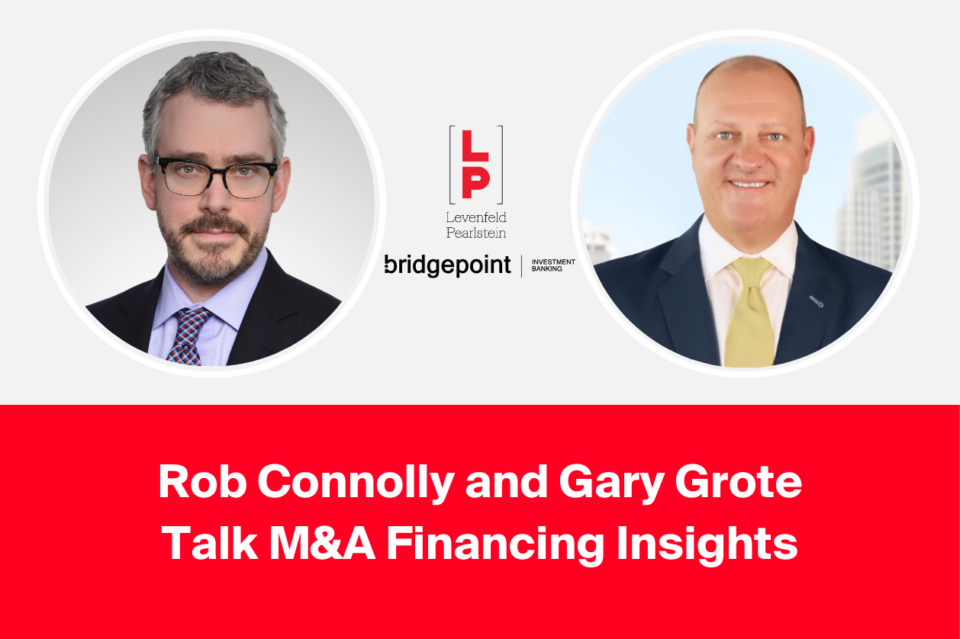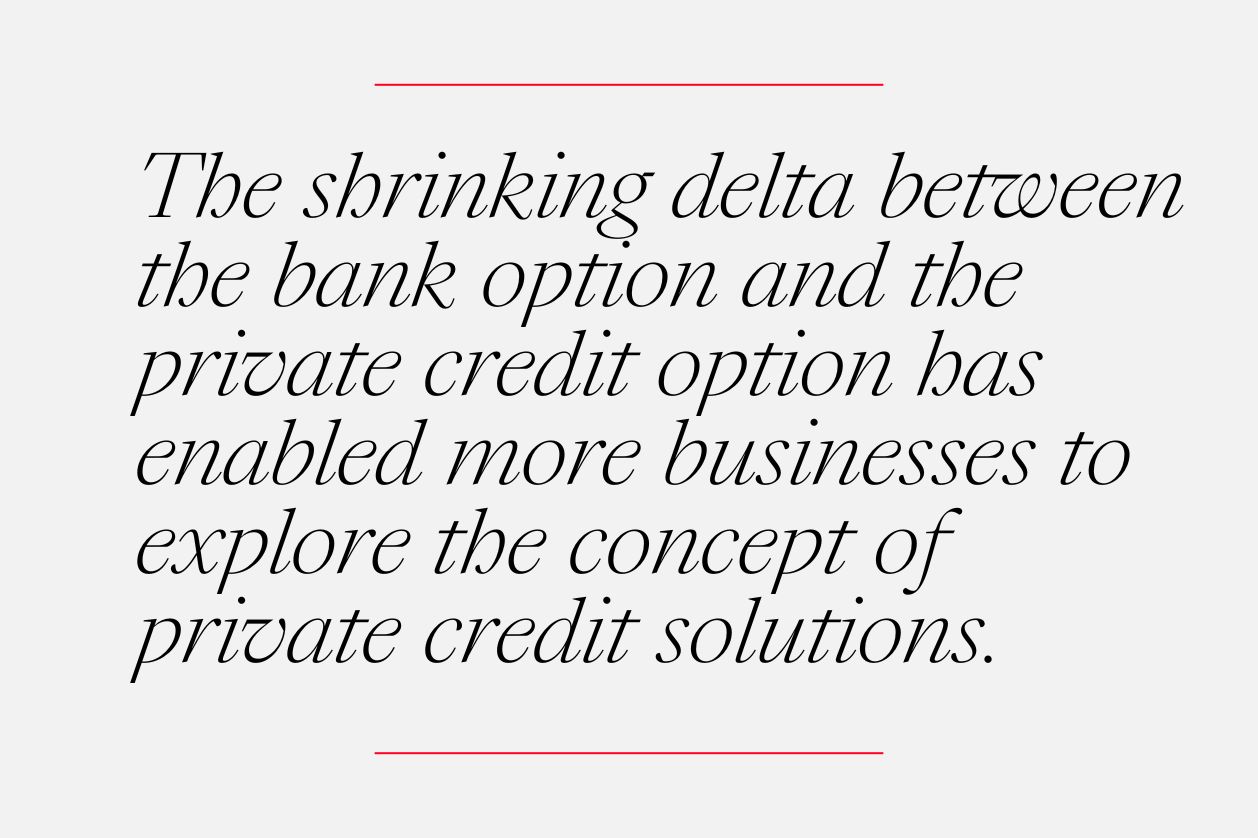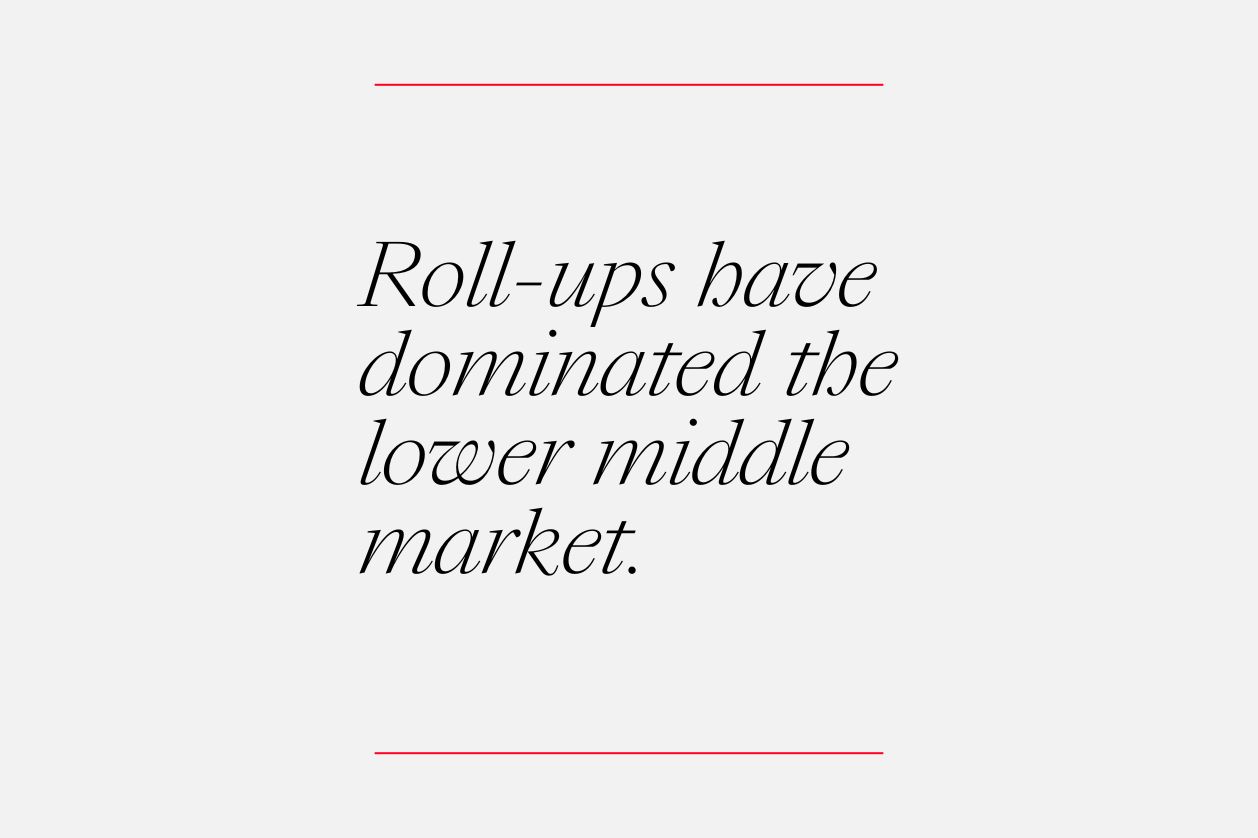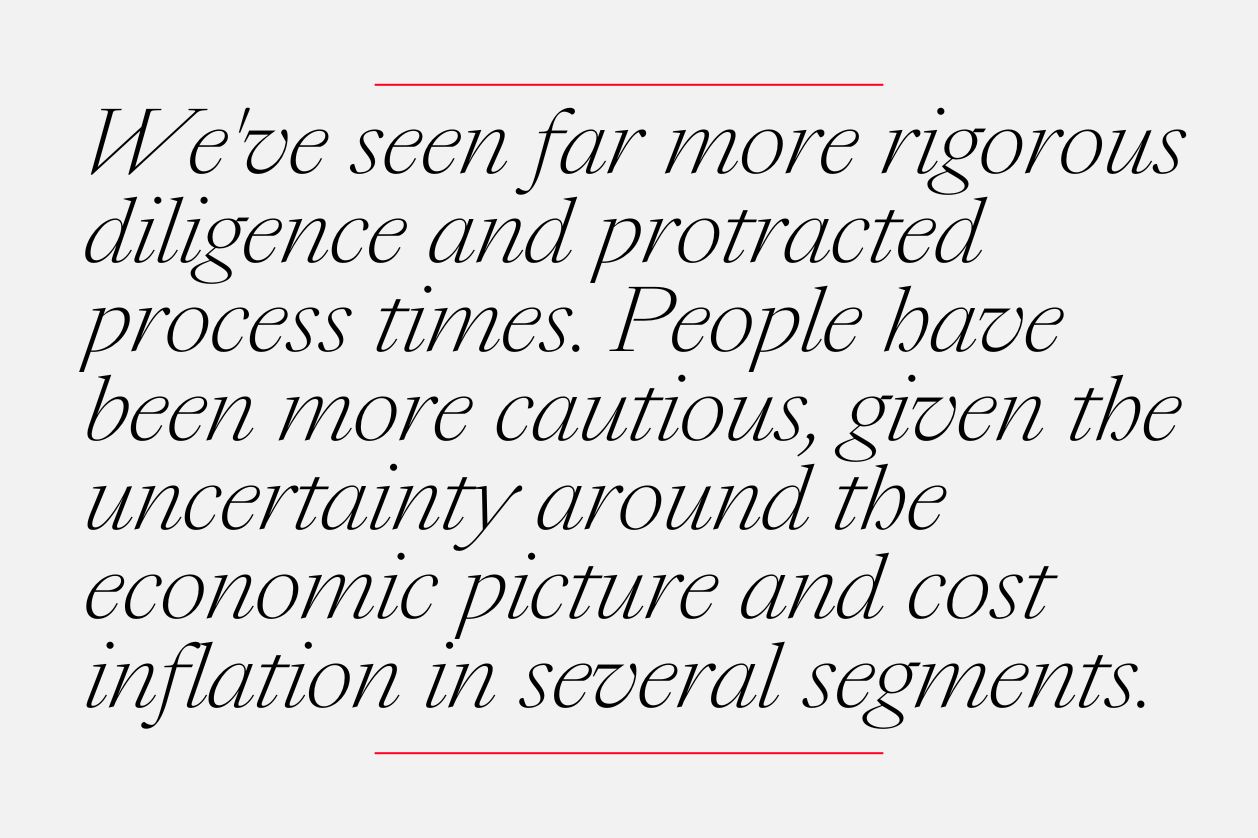M&A Insights and Outlooks Regarding Financing: A Conversation with Gary Grote of Bridgepoint Investment Banking

To help businesses, investors, and deal professionals better understand the evolving M&A market, Robert Connolly – a partner in and leader of LP’s Corporate Practice Group – shares a series of conversations with M&A experts.
Below is his conversation with Gary Grote, Managing Director at Bridgepoint Investment Banking, which focuses on capital raising and M&A advisory solutions. Gary focuses on deals in the healthcare, leveraged finance, financial services, and real estate industries. He has also worked on deals in the consumer and transportation sectors. In this Q&A, Gary discusses the financing landscape, how it impacts overall deal activity, and what may be on the horizon for M&A deals in the upcoming year.
The responses below have been edited slightly for brevity and clarity.
Current State of the Market
What’s the current state of financing for lower middle market deals?
At Bridgepoint, we work primarily with founder business owners. Our clients are often founders who have operated their businesses for several years and, during that time, dealt primarily with commercial banks and only thought about taking private equity funding if their desire for growth outpaced their bank credit line.
The commercial banking market continues to be conservative. The cost advantage to commercial banks, if they want to be involved in a credit deal, is not as positive as before the Fed’s rate increases. This has created a more flexible private credit market, as the delta in cost has been reduced.
There used to be a fair amount of sticker shock if a borrower wanted a more aggressive financing package than a commercial bank relationship could provide. Before the interest rate increases, mezzanine lenders had been largely squeezed out by aggressive banks or private credit uni-tranche deals. Some banks might have been willing to do at least four times senior leverage on deals, pushing total leverage to five or six times for companies with $10 million or less in EBITDA – a strong borrower might be able to get financing at 5-6% interest. At that point in time, the concept of a more flexible private credit solution, like a uni-tranche facility with up to six times leverage with fewer covenants and reduced amortization or cash payment requirements, would likely have been a 12% interest deal.

But now, the rates have basically doubled with banks. Commercial banks are requiring 2.5 times leverage rather than 3.5-4 times, and a 5-6% interest loan is now 9%. Those 12% interest private credit options from a few years ago are now 13-14%. The shrinking delta between the bank option and the private credit option has enabled more businesses to explore the concept of private credit solutions. However, it’s still new in most cases, especially to founder owners.
Even though private credit has higher interest costs and perhaps an inability to fix interest rate risk management, the interest rate delta isn’t that much higher than commercial bank loans and private credit options offer increased flexibility. I don’t have specific statistics, but in the past 18 months, there’s been a prevalent trend toward private credit versus senior bank debt to fund M&A transactions.
Are there particular sources of capital that are more active or available in this space?
A few years ago, the uni-tranche vehicle was very popular, which we still see, but we’ve also seen the re-emergence of mezzanine debt and sub-debt facilities. When rates were lower, uni-tranche facilities were preferred, but now borrowers with cheap fixed-rate debt don’t want to touch it, so coming in with a turn or two of sub-debt has made more sense recently.
How are changes in interest rates affecting deal financing and structures?
Until the past few days, many had been unconvinced that cuts in short-term rates are likely and were cognizant of the higher cost of capital continuing to impact borrowers’ financial statements. Accordingly, additional sensitivity analysis is being done with increased protections via structure. We’ll see with recent events if that changes, and if the Fed moves quickly to lower rates, which could make some funders more aggressive. Some private credit folks want a debt instrument, but we see more warrants now so investors can get a higher return on the back end when there is an expiration or a take-out.
Valuation and Pricing
What factors are driving valuation multiples in this segment?
Private credit folks typically don’t want more than 50% of the capital stack; in some of the more coveted sectors, that can be a limiting factor to valuation. For example, in an industry that might call for a double-digit price multiple, say ten times, there are probably not many people who want to finance up to five times. So, we are seeing fewer double-digit multiples in any sector except for a few in high-growth, recurring-revenue businesses.
In the first half of 2024, we’ve seen wide divergences by sector. Appetite and fervor are higher in some industries, like the industrial space. For instance, in our industrials practice, anything that touches infrastructure, particularly electricity, has an insatiable demand, especially electricity driven by AI. With microchips, people are racing, and there could be some exuberance on behalf of sponsors and purchasers in that territory. We certainly have seen double-digit multiples in that space. But other sectors that had been active in business services, healthcare, and consumer industries have been slow to return to the party, though we’re starting to see more activity.
The two factors impacting valuation multiples and middle market activity are (1) leverage being a turn or two lower, which has pulled valuations down a turn or two and (2) private equity exit activity.
The lack of substantial private equity exits is well-published and has put some sand in the gears of transaction activity. Within private equity, it is widely believed that pressures from limited partners demanding a return of their investment dollars will drive activity at the highest level, which will then trickle down and produce some grease for the middle market and lower middle market. We continue to hear from private equity folks now, more so than 6-9 months ago, that as they are fundraising, investors want to know about return of capital, as well as IRR and MOIC metrics.
Businesses need to show a track record of getting investors’ money back, which is one of the more encouraging things on the M&A front. Maybe there’s a soft landing in hand or a lighter recession than people had been calling for the last couple of years. We don’t anticipate M&A activity to be gangbusters, but the vast amount of private equity and private credit dollars that have been raised will need to be put to work at some point. This provides a hedge during softer economic times so the deal market doesn’t completely stall out.

Roll-ups have dominated the lower middle market. It was an historic low year in the amount of lower middle market platforms so private equity firms kept busy with add-on activity and we’re continuing to see that. One area where that has been particularly active is healthcare staffing. There has been a dramatic decline in performance in that sector post-Covid as travel nursing bill rates came down, and activity/appetite in that sector is much lower than it was. In a bargain-hunting environment, strategics are leading the charge in that area.
There’s also a shift in the healthcare staffing sector to different subsectors, depending on where you are in the labor supply chain. Businesses in higher compensated fields are far more in demand than nurse staffing. Home health had pumped the brakes, and now there could be more activity in that subsector. Also in the healthcare segment, one of the more notable trends is that the party seems to be over for huge multiples in the physician practice management space. People are far more cautious there due to the lack of organic growth activity and cost inflation, particularly on the labor front. Government reimbursement is not keeping pace with cost inflation so there are some fundamental structural issues which are limiting return possibilities.
Buyer and Seller Dynamics
Who are the primary buyers in the lower middle market today (e.g., private equity, strategic buyers)?
For a while, private equity dominated the lower middle market, but we’re seeing the return of the strategic buyers in our sectors. The lack of excessive leverage ability for the private equity buyers has leveled the playing field for the strategic buyers who don’t want to use as much leverage.

Regarding buyer-seller dynamics, we’ve seen far more rigorous diligence and protracted process times. People have been more cautious, given the uncertainty around the economic picture and cost inflation in several segments.
Another interesting trend we’ve heard is that there is far less apprehension, concern, or uncertainty about the election this year than we have in several previous election cycles. We haven’t seen the artificial urgency to get a deal done in 2024 before a change in administration or tax code that is present in most election years. There may be some concern about the advantageous capital gains treatment sun setting in 2025, but there is no magic to getting a deal done in 2024 based solely on that.
Process and Strategy
What are best practices for conducting due diligence in the lower middle market?
One of the things we’ve noticed over the last year that’s different from a couple of years ago is that those deals that are a little messy or have some hair on them don’t get done, rather than selling at a discount like would have been the case a few years ago. So, as advisors, we have been far more disciplined in the pre-market preparation of our clients, which has also slowed things down. People are aware of that. To have a quality asset in the market, you need to have a quality process. A lot more work is going into making sure clients are prepared to be in market.
Market Outlook
How do you expect the lower middle market M&A landscape to change over the next 1-2 years?
We expect 2024 to see a gradual return to a normalized trend of activity, and 2025 looks to be far more active in terms of M&A activity. In terms of macroeconomic trends, while we haven’t written off the possibility of a recession, we are probably just looking at a below-average economy. We likely won’t see a severe downturn, but there will be some downturn expected.
As limited partner investors’ demands for a return of cash spur additional private equity exit activity, there will hopefully be an increase in overall activity. With all the interest rate discussions, we still need to remember the demographics of our country. Many founder business owners in the Baby Boomer generation are tired of running their businesses and need to transition. We heard a lot about that five years ago with COVID and the market exuberance, and then we got away from that with interest rate discussions. However, we are seeing the corporate life cycle drive many M&A transactions now. People want to retire and might not have the internal transition plan.
What lessons have you learned from deals that didn’t proceed as planned?
In these deals, buyers were disciplined, rigorous, and relentless in their diligence. Instead of taking a “good enough” approach, they required issues to be fixed before closing. Now is a fine time to go to market, provided you are fully prepared to be a quality sale target or a quality borrower (if looking for debt or capital).
Reflection and Insights
Can you share a recent deal that exemplifies the current state of the lower middle market?
I will tell you two different stories that exemplify the current state of the market. First, we were involved in a healthcare staffing deal that was a case study on the impact of rising rates and leverage because several people backed away from the lending table. In the summer of 2022, when rates were increasing and the debt market fell apart, it caused a major re-trade in this staffing deal. We had to retrench and find a new buyer who wasn’t as reliant on leverage to close the deal. It was a long, protracted process that incurred challenges at every diligence stage but ultimately got done.
Fast forward to today. We have a deal in the electricity infrastructure market that recently closed. The deal will ultimately be 50% above our planning range because there was so much activity and appetite for a quality asset that the process set records in terms of IOIs, LOIs, and increased value from IOI to LOI throughout the process.
The takeaway is that if you have a good asset in a sector of favor, you can still get premium valuations in this market, but there are far fewer for those deals.
For more information on Gary Grote, view his bio. For more information on Bridgepoint, visit their website.
Interested in participating in a future interview series? Please contact Robert Connolly at rconnolly@lplegal.com.